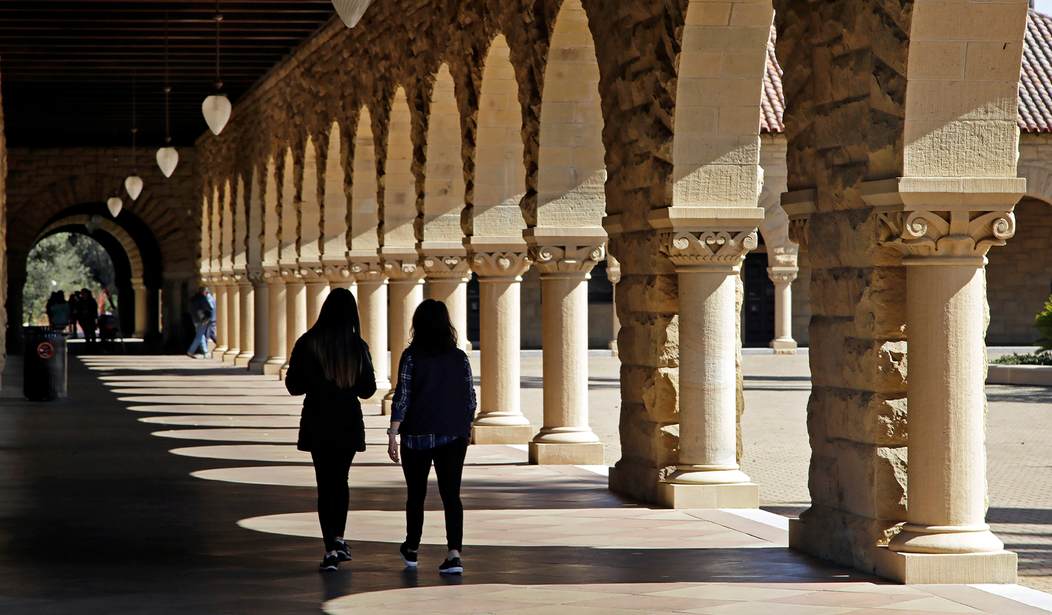(The opinions expressed by contributors are their own and do not necessarily represent the views of RedState.com.)
Stanford professor Dr. Jay Bhattacharya, co-author of the Great Barrington Declaration and self-described COVID lockdown skeptic, blasts the university in a powerful piece in Tablet that describes the administration’s attempts to censor and intimidate him for scientifically (and correctly) pointing out that mandatory lockdowns didn’t work. He was an early and influential voice in objecting to the harmful, draconian policies enforced on populations here and abroad, and he’s paid a heavy price for it.
In his piece, titled “How Stanford Failed the Academic Freedom Test,” Bhattacharya reminds us of how far people in power were willing to go to hide information and discussion from the public in order to keep the money spigots flowing. With so many of the same people preaching now about how we should forget and move on, Bhattacharya shows us why we should never forget, and why those who were behind it should be held accountable.
COVID mania attained an almost religious fervor, he writes:
The COVID-19 pandemic has apparently brought us full circle, with a public health clerisy having replaced the religious one as the singular source of unassailable truth.
Bhattacharya initially became the target of censorship with his release of the GBD, which was one of the first and most important refutations of Fauciism. In the paper, he, Harvard professor Dr. Martin Kulldorff, and Oxford professor Dr. Sunetra Gupta argued that lockdowns weren’t the answer to slow the spread; focused protections on the vulnerable should have been the path forward:
Mortality from #COVID19 differs more than a thousand-fold between the old and young. Focused protection is the compassionate approach that balances COVID risks and collateral damage to public health.https://t.co/63I0hcZK1J
— Jay Bhattacharya (@DrJBhattacharya) August 23, 2021
The blowback was swift. At first, tens of thousands of scientists, epidemiologists, and physicians signed the document, but Bhattacharya described how the mood suddenly changed:
The plan received the attention of the American press, at first curious and fair, but soon thereafter hostile and tendentious. I started getting calls from reporters, including outlets like The New York Times and Washington Post, asking me why I wanted to “let the virus rip” through the population, even though that was the very opposite of what we were proposing, and questioning my credentials and motives.
The crux of public health authorities' immense power is their capacity to cause fear at a society-wide level in the name of The Science™️.
— Jay Bhattacharya (@DrJBhattacharya) January 10, 2023
It was discovered a year after the Declaration’s publication that then-head of the U.S. National Institutes of Health Francis Collins had written an email to Anthony Fauci calling the three GBD scientists behind the paper “fringe epidemiologists.” Bhattacharya believes that’s when Stanford’s campaign against him began:
Collins and Fauci sit atop tens of billions of dollars that the NIH uses to fund the work of nearly every biomedical scientist of note in the United States. Stanford University receives hundreds of millions of dollars of funding from the NIH, without which researchers would not have the resources to conduct many worthwhile experiments and studies…
The most egregious violation of academic freedom was an implicit decision by the university to deplatform me. Though I have given dozens of talks in seminars at Stanford over the past decades, in December 2020, my department chair blocked an attempt to organize a seminar where I would publicly present the ideas of the GBD. [Emphasis mine.]
It only got worse from there. Dr. Bhattacharya and others who dared express sentiments similar to his were frozen out of discussion panels and academic discourse:
Stanford failed to create a work environment where these discussions could happen…
The university’s refusal to defend dissenting voices created an environment in which slander, threats, and abuse aimed at lockdown critics could flourish.
Not only was discussion not encouraged, but it was also actively fought against—by Stanford’s own faculty. A secret petition circulated by another scientist demanded that the school censor Dr. Bhattacharya over testimony he gave to Florida Governor Ron DeSantis which he says was—and still is—accurate. “This petition imposed unethical pressure on faculty members—especially junior faculty members worried about tenure votes—to sign on,” he writes.
Posters were distributed around campus with Bhattacharya’s photo and a quote of his, “By vaccinating the old, we have protected the vulnerable.”
“The implication was that I was a thought-criminal whose work was somehow responsible for the inevitable spread of a highly infectious respiratory virus,” Bhattacharya writes, noting that the posters were an obvious attempt at intimidation. What did Stanford do in response? You guessed it: nothing.
Dr. Bhattacharya sums up his ordeal with a powerful indictment of the thought police running the university:
Academic freedom at Stanford is clearly dying. It cannot survive if the administration fails to create an environment where good-faith discussions can occur outside of a framework of ideological rigidity and the false certainties that ideologues—and governments—wish to impose on us…
In this environment, professors and students alike would be wise to look over their shoulders at all times, in the knowledge that the university no longer has your back.
This is not some guy sitting on his couch in his underwear tweeting, “I refuse to wear a mask!” Dr. Bhattacharya and his colleagues are nationally respected scientists who backed up their conclusions with scientific data, yet they were maligned and censored by their own colleagues and administrators.
American campuses were once famous for their tolerance and encouragement of free speech—yet now many of them have simply given over to censorious regimes.
The irony is that Bhattacharya has been proven correct in everything he said—lockdowns obviously didn’t work or Florida would have had a much worse outcome than the prison that was California. That did not happen. Stanford’s reaction was shameful; it should have been protecting free speech at all costs.
Instead, it sold its soul for more NIH money.
This piece is a bit more personal and was very hard for me to write. It is on how Stanford University, my home, failed to live up to its ideals during the pandemic.https://t.co/h0nRr7RjiP
— Jay Bhattacharya (@DrJBhattacharya) January 11, 2023
–> See also:














Join the conversation as a VIP Member